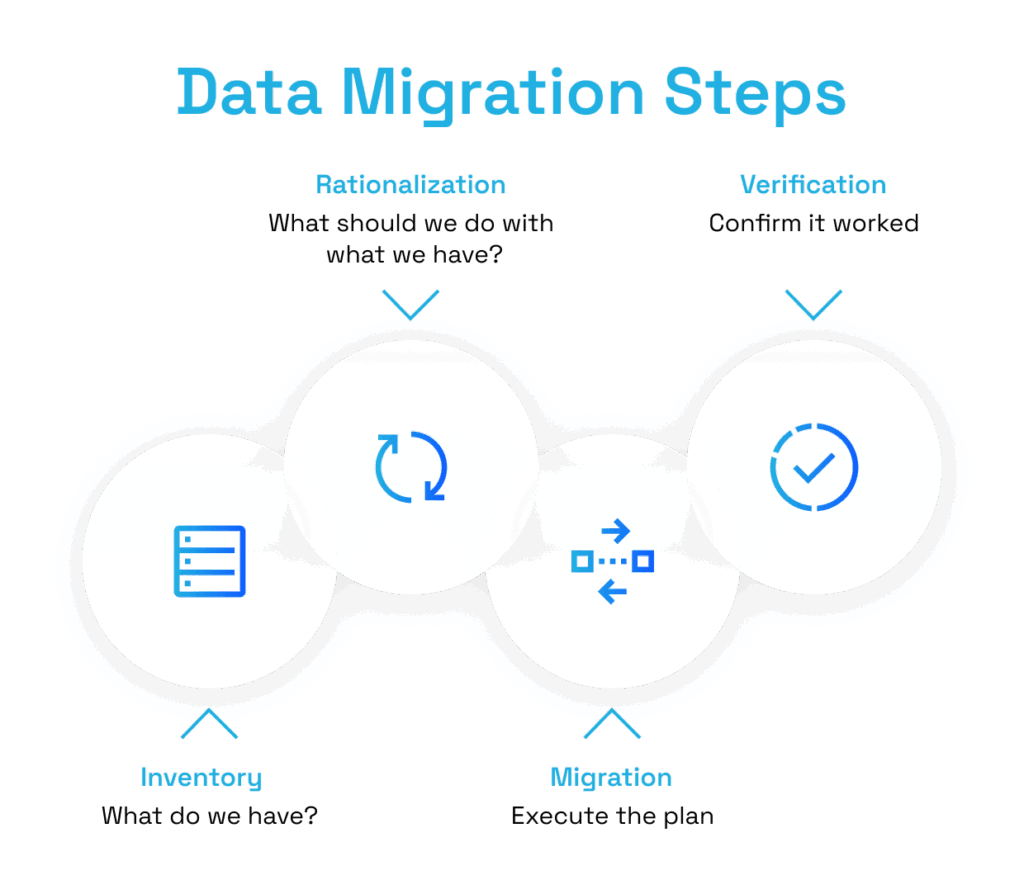The data strategies of yesteryear are aging at an accelerated clip, becoming a growing liability for the businesses they were designed to serve.
While competitors leverage modern cloud or hybrid architectures for faster insights and lower costs, organizations stuck on decades-old systems find themselves paying premium prices for diminishing capabilities.
Whether you’re moving from legacy platforms like Teradata to modern cloud architectures like Snowflake, or modernizing sprawling Hadoop ecosystems, the fundamental challenge remains the same: how do you move critical business data and applications without disrupting operations while unlocking new value?
After executing dozens of large-scale enterprise migrations spanning $6B airlines to $200B global beverage companies, Hakkoda’s migration experts have identified a proven four-phase framework that consistently delivers successful outcomes.
This approach, enhanced by AI-powered accelerators, transforms what was once a multi-year gamble into a predictable, value-driven journey.
The Four-Phase Migration Framework
All successful data migrations, regardless of scale or target platform, follow a consistent pattern:
- Inventory – What do we have?
- Rationalization – What should we do with what we have?
- Migration – Execute the plan
- Verification – Confirm it worked
This progression mirrors how organizations naturally approach change management, but the devil lies in the details of execution.

Phase 1: Inventory – Discovery Beyond the Obvious
Inventory is more than cataloging known assets. It’s detective work that uncovers the hidden integrations, forgotten dependencies, and undocumented workflows that can derail migration efforts.
What gets inventoried:
- Data sources, volumes, and formats across all environments
- Database schemas, tables, views, and stored procedures
- ETL/ELT pipelines and orchestration workflows
- Data applications that directly integrate with the enterprise data warehouse
- Reports, dashboards, and analytical workloads
- User personas and access patterns
- Integration touchpoints and data flows between systems
- Business value assessment and total cost of ownership analysis for each data product to directly inform migration prioritization decisions
The discovery challenge: Hakkoda recently worked with a client who discovered critical integrations they weren’t aware of during inventory. These “unknown unknowns” would have caused significant impact to the migration efforts, increasing scope and pushing delivery dates to ensure the business didn’t experience disruption during the migration. Comprehensive discovery during Phase 1 prevents these costly surprises later in the process.
AI-powered discovery can automate much of this detective work. Modern tools scan code repositories, analyze database schemas, map data lineage at scale, and use natural language querying to explore “what if” scenarios during planning. This automation dramatically improves inventory comprehensiveness while reducing the time required for manual discovery.
Stakeholder engagement during inventory proves critical for uncovering institutional knowledge. Business users often understand data relationships and usage patterns that aren’t documented anywhere. Senior business leaders and business process experts must provide guidance from the start to drive alignment and ensure nothing critical gets missed.
Phase 2: Rationalization – Strategic Decision Making
Rationalization transforms inventory data into actionable data migration strategy. This is where technical discovery meets business strategy, and where most migration plans succeed or fail.
Rationalization must be led by the prevailing business strategy, not just technical best practice. In some contexts (tight license deadlines, mandated cost cuts, or major organizational change), boards will deliberately choose a lift-and-shift to retire infrastructure fast, accepting short-term technical debt to meet near-term outcomes.
The rationalization phase should make these trade-offs explicit: document the rationale, ring-fence the debt, and sequence modernization waves that follow the lift-and-shift once risk, funding, and change capacity allow.
In other words, Rationalization isn’t about the “perfect” architecture on day one. It’s about aligning migration decisions to business timing, constraints, and value, while laying a clear path to modernization when the strategy (and the calendar) says it’s time.
Key decisions during rationalization:
- What data gets migrated, archived, or retired
- How data structures should be modernized or transformed
- Which applications can be lifted-and-shifted versus rebuilt
- What security and access control policies transfer versus require redesign
- How data governance frameworks transfer and evolve in the new platform
- How to manage business continuity during migration – pausing new development in source systems versus managing ongoing changes throughout the migration
- How to sequence migration work for maximum business value with minimum risk
Value-based wave planning forms the heart of rationalization. The most successful migrations sequence work based on highest business value with lowest technical risk and dependencies, directly leveraging the value assessments and TCO analysis completed during inventory. This approach is highly subjective to each client’s specific situation and business priorities.
Wave 1 typically includes high-impact, low-complexity assets that deliver quick wins and build organizational confidence. These “no regrets” migrations prove the approach works while generating early value. Subsequent waves tackle increasingly complex systems with the benefit of lessons learned from earlier waves.
Critical architectural decisions emerge during rationalization: Access control policy migration deserves immediate attention. Will current policies transfer as-is, or will users need to re-request access to everything they need? This seemingly technical decision has massive operational, security, and change management implications that ripple throughout the entire migration.
Skills development strategy should be defined during rationalization. Integrating client resources into migration efforts as much as possible allows those resources to organically gain skills in the new platform. This enables smoother transition of operational support as legacy systems are decommissioned.
AI-powered analysis can accelerate rationalization by automatically categorizing assets, identifying optimization opportunities, and generating summary recommendations. Natural language querying allows teams to rapidly explore different wave scenarios and their implications.

Phase 3: Migration – Execution with Minimal Disruption
Migration execution balances speed with stability, aiming to reach critical value inflection points while minimizing business disruption.
Key execution principles:
- Deliver quick wins early to maintain organizational momentum and stakeholder confidence
- Accelerate user cutover by starting adoption activities on day one, not waiting for technical completion
- Maintain operational integration so business processes continue seamlessly
- Execute comprehensive data governance and security from the start, not as an afterthought
- Build flexibility to support new requirements that emerge during migration
The parallel run challenge requires careful planning and clear agreements upfront. Successful parallel operations must establish:
- Agreement on the duration of parallel runs
- Agreement on what exactly gets compared during parallel runs across data domains
- Agreement on reconciliation approaches when differences appear
- Clear escalation paths when issues arise
Operational metadata and job scheduling present unique challenges when moving to cloud platforms. Mimicking on-premises approaches for operational metadata capture isn’t always effective—cloud platforms work faster and require new agreements around these processes. Business input becomes extremely critical while defining new parameters, such as when end-of-day processing needs to change to intra-day processing.
Data management during migration requires understanding how data moves from one system to another, along with mechanisms for capturing operational metadata and resiliency features to recover from errors. Source system data changes frequently, which can create reconciliation problems at quarter-end reporting periods. Regular data refresh prevents errors and avoids the need for full reloads.
AI-powered acceleration transforms migration execution. Code conversion and optimization can be largely automated, while automated testing and validation reduces verification time and improves quality. However, this automation enhances rather than replaces human judgment about migration sequencing, risk management, and business priorities.
Change management execution runs parallel to technical migration. Communication plans must keep impacted users informed throughout their journey rather than surprising them at cutover. Training and enablement for key change leaders and champions drives adoption from the beginning of migration, not just at the end.
Phase 4: Verification – Proving Success
Verification encompasses both technical validation and business acceptance. It’s not enough for data to move correctly. Users must successfully adopt new systems and realize intended value for your data migration strategy to be truly successful.
Technical verification includes:
- Data integrity and completeness validation across all migrated assets
- Historical data validation with well-defined approaches separate from reconciliation processes
- Performance benchmarking against source systems to ensure acceptable response times
- Security and access control testing to confirm policies work as intended
- Integration and workflow validation to ensure end-to-end processes function correctly
Historical data validation deserves special attention for large-scale migrations. The reconciliation approach must be decoupled from validation—reports should clearly call out differences rather than attempting to mask discrepancies. This transparency helps teams understand what changed and why, rather than creating false confidence in perfect matches.
Business verification focuses on:
- User adoption metrics and qualitative feedback from actual users
- Business process continuity confirmation across all affected workflows
- Value realization measurement against original migration objectives and TCO projections established during inventory
- Operational handover to steady-state teams with proper knowledge transfer
Contingency planning becomes critical during verification. Benchmarking against results from prior migrations provides insights into how significant any remaining deltas are and whether they warrant specific action. Detailed contingency plans with specific actions, roles, responsibilities, and timelines help avoid cost overruns and delays when issues arise.
Automated documentation and testing powered by Gen AI ensures knowledge transfer happens continuously rather than as a final step. This automation generates comprehensive documentation while reducing the manual effort required for testing and validation.

The Iterative Nature of Migration Waves
Rather than attempting massive big-bang migrations, modern enterprise data migration strategies are phased out into multiple waves, with each wave following the complete four-phase cycle. This iterative approach manages risk while delivering incremental value.
Discovery and Pilot Phase (Wave 1) establishes the foundation, validates approaches, and builds initial capability. This phase includes comprehensive inventory, initial rationalization for wave planning, pilot migration of representative workloads, and verification of the overall approach.
Wave 1 focuses on high-value, low-risk assets that deliver quick wins and build organizational confidence in the migration approach. Success in Wave 1 proves the methodology works and generates early business value.
Subsequent Waves tackle increasingly complex systems, sequenced by business priority and technical dependencies. Each wave benefits from lessons learned in previous waves, with approaches refined and risks better understood.
Cross-cutting activities span the entire migration timeline:
- Program governance ensures consistent decision-making and risk management
- Change management maintains organizational alignment and drives user adoption
- Value orchestration measures and communicates business benefits throughout the journey
Different tracks—Enterprise Data Warehouse, Applications, Data Exchange, Users, Report Remediation—progress in parallel but at different paces based on complexity and dependencies. This parallel execution accelerates overall timeline while managing risks through careful sequencing.
Organizational Transformation Through Migration
The most successful migrations recognize that technology change is fundamentally organizational change. Technical migration success depends on organizational readiness, user adoption, and operational effectiveness of new capabilities.
Communication and stakeholder engagement must address the broad numbers of business leaders and users impacted by rapid change. There needs to be frequent communication to bring impacted users along the journey, not just inform them of decisions already made.
Security and data privacy concerns require immediate attention. Access control decisions affect every user and require careful change management. Data governance frameworks must evolve to leverage new platform capabilities while maintaining regulatory compliance. Data privacy regulations may impose additional constraints on migration approaches and timelines that must be addressed from the beginning.
Operational readiness encompasses more than technical capability. Teams need well-defined processes for data environment management, including scrubbing data when reverse loading data from higher environments to lower environments. Support architecture should include dedicated cloud platform technical architects who can work with infrastructure teams to speedily resolve issues during migration periods.
Value realization isn’t measured by technical completion—it’s measured by business value delivery, user adoption, and operational effectiveness. Employing rapid development labs for ideation and co-creation helps businesses leverage new platform capabilities sooner while maintaining focus on large-scale migration objectives.

Turning Your Data Migration Strategy into a Competitive Advantage
Data migration, executed thoughtfully, transforms from a necessary technical exercise into strategic business advantage. The four-phase framework provides structure for managing complexity while the wave-based approach delivers incremental value throughout the journey.
Success depends on execution details: comprehensive inventory that uncovers hidden dependencies, strategic rationalization that prioritizes business value, careful migration that minimizes disruption, and thorough verification that proves value realization.
Modern, AI-powered accelerators significantly improve migration speed and quality, but they enhance rather than replace the need for strategic thinking, stakeholder engagement, and change management.
The organizations that approach migration as holistic transformation—technical, operational, and cultural—consistently achieve better outcomes than those focused purely on technical execution. The question isn’t whether to migrate legacy data platforms, but how to do it in a way that maximizes business value while minimizing risk and disruption.
Migration success extends beyond technical completion to the new analytical capabilities it enables. Modern cloud platforms transform data into a strategic asset, supporting advanced analytics, real-time insights, and AI applications that weren’t feasible on legacy systems.
Your migration isn’t just about modernizing systems—it’s about unleashing AI, real-time insights, and faster decisions. Let’s talk today.





